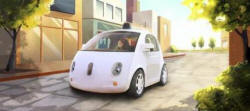|
 Google
building self-driving cars with no driver seat, steering
wheels Google
building self-driving cars with no driver seat, steering
wheels
 Send a link to a friend
Send a link to a friend
[May 29, 2014]
By Alexei Oreskovic
RANCHO PALOS VERDES Calif.
(Reuters) - Google Inc is building cars that don't have
steering wheels, accelerator pedals or brake pedals, in
an ambitious expansion of the Internet company's efforts
to develop self-driving cars.
|
|
 The small electric cars, which seat two passengers, are currently
prototypes that Google has been building through partnerships with
automotive suppliers and manufacturers, Google co-founder Sergey
Brin said at the Code conference in Southern California on Tuesday. The small electric cars, which seat two passengers, are currently
prototypes that Google has been building through partnerships with
automotive suppliers and manufacturers, Google co-founder Sergey
Brin said at the Code conference in Southern California on Tuesday.
Google aims to build up to 200 such cars in the near term and hopes
the vehicles will be available in various cities within a couple of
years, he said.
Google has been testing self-driving cars since 2009, incorporating
laser sensors and radars into standard automobiles such as the Prius
from Toyota Motor Corp and sport-utility vehicles from Toyota luxury
car division Lexus.
While those vehicles require a human to remain in the driver's seat
and to take over in certain situations, the new cars operate
completely autonomously.

Brin said the cars could operate as a service, picking up passengers
when summoned, and potentially even operate as fleets of
interconnected "trains".
"Ten seconds after getting in I was doing my email, I had forgotten
I was there," Brin said of his experience riding in one of the
pod-like vehicles, which resemble a cross between a Smart car and
Volkswagen Beetle. "It ultimately reminded me of catching a
chairlift."
Brin declined to specify whether Google intended to build and sell
the cars itself, saying only that the company would "work with
partners".
The driverless cars are currently limited to a maximum speed of 25
miles (40 km) an hour, but Brin said there was no reason the cars
could not go as fast as 100 miles an hour or more once they had been
proven to be safe.
[to top of second column] |

The front of the cars contain about 2 feet (61 cm) of foam and the
windshield is made out of plastic instead of glass to make the cars
safer, he said.
"Within a couple of years I hope we will surpass the safety metrics
we've put in place, which is to be significantly safer than a human
driver, and we will start testing them without drivers and hopefully
you'll be able to utilize them at some limited cities," Brin said.
A handful of U.S. states, including California and Nevada, have
passed legislation to allow testing of self-driving cars on public
roads. Brin said he was optimistic that the new, passenger-only
self-driving cars would be approved for testing in the U.S. and
overseas in the future.
(Editing by Christopher Cushing)
[© 2014 Thomson Reuters. All rights
reserved.] Copyright 2014 Reuters. All rights reserved. This material may not be published,
broadcast, rewritten or redistributed.
 |